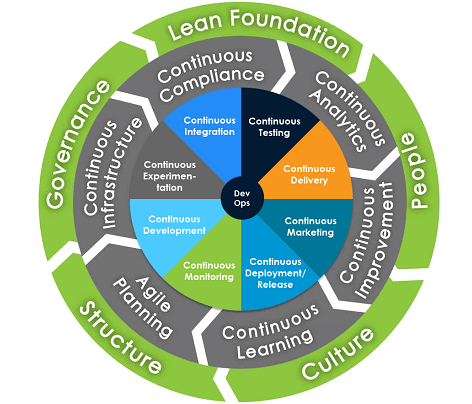Can an IT operations team be the catalyst for enterprise transformation?
December 18, 2017 | By Jay Mozo

So you head up the operations team at a fairly major enterprise. Your team is pretty competent—they get software-defined networking, they know how to script in a few languages. They’re as excited about DevOps as your developers are…well, maybe not quite as much. They’re working to automate pieces of your infrastructure and want to expand upon that success. They truly want to help your dev team deliver better products faster.
But you’ve encountered a few setbacks along the way. You realized the code was bypassing some important processes. Maybe you ran afoul of the InfoSec team, who is nervous about taking away manual compliance safeguards. You found your current budget structure doesn’t allow you to work on projects you know will deliver value, or buy the new tools you need. And you have to wait a whole year to make new budget requests.
The thing is, these setbacks are much larger than your team. They’re deep-seated cultural norms and processes that occur at the enterprise level. And you can’t fix them … or can you? And maybe in doing so, you can become a catalyst for important changes in your organization.
Where to start: What the ops team CAN do
Hear this now: DevOps isn’t just a culture, and it also isn’t just automation. A culture of alignment and operationalized feedback loops alone will help you make better decisions, but you need automation to produce faster and scale better.
Your organization may not be ready for a high level of automation and a full DevOps culture shift—but it may not ever be ready if you don’t start somewhere. After all, when you build the case for high-level overhaul of budgets and team structures, you need to show early successes and the ability to adapt to the changes you propose.
The first steps in transforming your operations team into a velocity and value machine—and showing the organization that DevOps culture is possible—is to work on your team culture, people and team alignment around the right goals.
Where does the operations team fit in? I’ve broken out DevOps into three rings, which you can see in the illustration below.
-
Outer ring
Enterprise-level activities that will eventually need to shift. This is the change you’ll be driving toward, but you probably have no direct control over this.
-
Middle ring
Process and technology changes that your operations team can absolutely drive.
-
Core (center)
Product team activities that deliver direct value to customers.

A plan for driving DevOps transformation in operations
Here’s how an IT operations leader can build and enable innovation, speed and value:
Culture
DevOps—and pretty much any approach that increases your velocity—requires a decentralized, bottom-up approach. Are you personally ready to relinquish some control? Is your team ready to embrace their empowerment and figure out how to work through issues without you?
Agile
Agile is more than Post-its and standup meetings. To support your customers better, you’ll need to understand the Agile development methodology. Don’t worry so much about the trappings of sprints and standup meetings until you need to—but truly understand and embrace the principles in the Agile manifesto.
Alignment
I know, another management buzzword. But when you truly understand DevOps, you’ll realize it means something special—aligning people, process and technology around the right goals that make you nimble and quick (and able to jump over the candlestick). Better yet, jump over the would-be Amazons out to disrupt your business.
What does this mean in practical terms? The grey ring in my illustration—continuous compliance, improvement, learning, infrastructure and analytics, plus Agile planning, represent the core tech platform and processes you’ll need to align your goals and teams around. This will probably mean restructuring your teams and building the culture and rhythm to keep them working toward the same goals with the same context.
You should start by mapping the operations goals that support your development team better, such as creating a modern infrastructure that:
- Allows fast deployment of code
- Can scale with more data and platforms
- Is safe (has built-in guardrails and governance)
- Has an interface that makes sense to developers
- Is future-proof
These are generally useful goals to consider but it’s likely your business has some unique needs as well, which you can uncover using value stream mapping. (Yes, if you’re playing Buzzword Bingo, you can collect another chip).
Turning roadblocks into opportunities
Operations teams have a lot to prove. Right now, a lot of people in your company probably think you’re the roadblock. Developers love to point fingers at your team when they fall behind in delivering the products and features your customers want.
But you have a chance to upend that reputation. Meaningful DevOps changes will allow your operations team to move at the speed of development, with the safety of InfoSec and the efficiency of ITSM.
Plus, as my colleague Jay Long says, if your operations team waits for developers to do all the DevOps planning, you’re not going to be happy with the outcomes.
It won’t be easy. An operations team can’t make full DevOps transformation happen by itself—you’re going to run into many roadblocks, like budgeting cycles that seemed designed to thwart the speed and agility you seek, and siloes between other teams. But enabling faster, safer development will win you a lot of friends and goodwill, and the roadblocks are actually opportunities to start conversations above your pay grade about enterprise-level issues.
Your call: Will you remain the organization of no, or will you become the change agent in your enterprise?
Jay Mozo is the chief principal practice architect for DevOps services at TEKsystems.
Starting your DevOps journey?
We can help accelerate adoption.